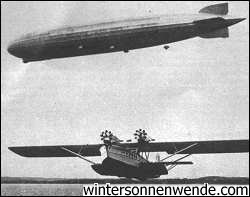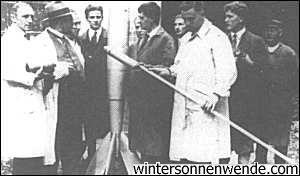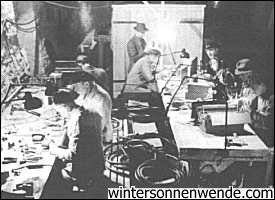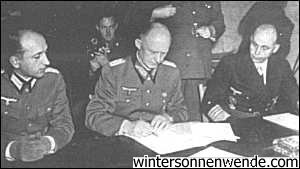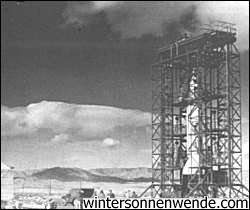|
The Great Patents Heist
Article from the The Barnes Review, March/April 1999, pp. 27-33.
It is quite acceptable to American pride to acknowledge that immigrants have contributed to our prosperity and greatness. It's a little harder to swallow that a good deal of our scientific lead and prosperity - despite the ever-increasing burdens of non-skilled illegal immigrants and unproductive home-growns - has come from simply seizing German patents and inventions after World War I and far more so after World War II.1 There are those who claim the key to America's felicity has been its Jewish citizens. After all, this is now a "service economy" of stockbrokers and financial and entertainment services. Could America dispense with actually manufacturing or growing anything, and instead focus on the essentials like Broadway shows, Hollywood sitcoms and currency speculation? The message of Bernt Engelmann's 1974 Deutschland ohne Juden, published in English by Bantam Books, New York in 1984 as Germany Without Jews, is clear: You Germans were mediocre until we Jews came, and now that we're gone, you have sunk back into mediocrity. Engelmann cites endless lists of great Jewish MDs of German or Austrian domicile, several of whom, such as bacteriologists Paul Ehrlich (1854-1915) and Robert Koch (1843-1910), won the Nobel Prize in medicine and physiology (Ehrlich, 1908; Koch, 1905). [Scriptorium comments: Robert Koch was not Jewish.] Sigmund Freud (1856-1939), of dubious credentials, is one of Engelmann's prize examples. Engelmann also slays entire forests with pages of printed paeans to forgotten Jewish playwrights, songsters, operetta producers, critics, publishers etc. How could one forget the immortal Meyerbeer? To the wary eye, it smacks of ethnic self-congratulation. One gifted Jew writes a piece, another publishes it, yet another reviews it favorably, a fourth sits at the box office counting out his money and a fifth takes his 10 percent as agent - an unconvincing proof that the nation of Mozart, Bach and Beethoven needed music lessons. Gottlieb Daimler (1834-1900) and Karl Benz (1844-1929) invented the modern gasoline engine in 1878-1887. Other Germans took the lead in 19th-century chemistry and created the first contact lens (in the 1880s), X-rays (Wilhelm Roentgen in 1895), quantum physics (discovered in 1900 by Max Planck, 1858-1947), aspirin (acetylsalicylic acid) and last (and least), saccharin in 1913. As for previous centuries, the Germans got no credit for inventing the croissant or "Kipferl," as the Germans call it, in Vienna to celebrate defeating the Turks in 1683; one notes the Turkish religious logo, the crescent (a baked good then snatched up by the French as the "croissant"). Equally, they receive zero credit for baking the first quiche, which in Lorraine and Rhinelander dialects ("Kiisch") simply means "kitchen leftovers baked into a pie." Baked goods aside, the facts reveal that the most creative period in world history may have been Germany between 1932 and 1945, and that much of America's scientific lead came from looting German patents by the ton, both in World War I and far more so after World War II. And because Germany was so devastated after World War II, there has been a brain drain ever since of the top young German scientists - to Massachusetts and California for computers and genetics and to greater Los Angeles, Houston and Cape Canaveral for aerospace. As one German scientist remarked: "Since the war, we have not had the financing capabilities for basic research for the long-term future. That kind of serious money only the Americans have. In Germany, and in Japan, also, we do applied and clinical research for immediate applications. But to be on the cutting edge, the money and the positions are now in America and we have to go there."2 An astounding admission of the stripping of German inventiveness after the war came in an October 1946 article by C. Lester Walker in Harper's magazine. Entitled "Secrets by the Thousands,"*** it presents some problems for the Bernt Engelmanns of this world who imply that German science in the 1932-45 period would have been "nothing without the Jews." In fact, the article suggests in deadly seriousness that German Chancellor Adolf Hitler had been right, from his point of view, to prolong the war to the last gasp. According to the deputy commanding general of Army Air Forces Intelligence, Air Technical Service Command, in a speech to the American Society of Aeronautical Engineers, "The Germans were preparing rocket surprises for the whole world in general and England in particular which would have, it is believed, changed the course of the war if the invasion had been postponed for so short a time as half a year."
Just as the war was ending, and President Franklin Roosevelt was ordering both Gens. George Patton and Dwight David Eisenhower to pull back and let "Uncle Joe" (Josef Stalin) have Berlin and Eastern Europe, the Germans had been readying their giant A-4 rocket for production. Forty-six feet in length, it weighed over 24,000 pounds and could travel 230 miles - rising 60 miles over the earth to a blistering top speed of 3,375 miles per hour. Its secret was a rocket motor running on liquid nitrogen and alcohol. It was either radar controlled or self-guided by a gyroscope. Since it flew faster than the speed of sound (by many times), it could not be heard before it struck.
But most Americans know about German World War II rockets. A few even know that in addition to the car engine the Germans also invented the jet and perfected the superhighway or autobahn (the three most important inventions binding this vast country [i.e. America; Scriptorium ed.] together). Virtually no one knows that in Wright-Patterson Field in Ohio, in the Library of Congress and in the Department of Commerce in Washington, a "mother lode" of 1,500 tons of German patents and research papers were being mined furiously after the war. One gloating Washington bureaucrat called it "the greatest single source of this type of material in the world, the first orderly exploitation of an entire country's brain power." Fortunately, it was for the benefit of the United States, which, having thwarted Hitler's crusade against the Soviet Union, had to take up the same gauntlet against a communism spread worldwide by the late 1940s. The genesis of the project to grab German secrets was in 1944, when, amazed by German technology in everything from rockets and jets to Tiger tanks, a Joint Intelligence Objectives committee was set up to confiscate German inventions the instant they were obtained, even before the surrender, for use against Japan. Even before reaching the German border, fascinating discoveries began to be made, including one with which every American is familiar: audio tape. The 1946 Harper's article shows the head of the Technical Industrial Intelligence Branch, in quaint excitement:
A Short History of Recording and Its Effects Upon Music by Michael Chanan4 points out that even in the late 1920s, before the "12 darkest years of German history,"5 one Fritz Pfleumer had developed a plastic recording tape. It was launched commercially by BASF6 in 1934. The idea was based on the film strip, and its original application was for dictation in an office environment. In Britain, a project funded by the great radio genius Guglielmo Marconi was attempting the same thing. (On D-Day, the Americans played audio tapes of combat loudly at various locations to try to throw off the German defenders.) However, the great leap forward came when one A. M. Poniatoff, president of a small California company called Ampex (a trade name still familiar to the older generation), then wearing a U.S. Army uniform, helped seize German-held Radio Luxembourg in late 1944. Instantly grasping the gold mine in profits and quality which the Magnetophone tape represented, Poniatoff had the 3M Company rush the new tape into American production, and it swept the Los Angeles entertainment industry. Its major breakthrough came in 1947 when Bing Crosby first used it to record his network shows. The crooner not only preferred the Magnetophone sound but invested heavily in Ampex. Later, movie soundtracks went onto audio tape as well, improving mixing and dubbing efficiency as well, and avoiding the infuriating mishap where a successfully shot movie scene had to be retaken due to sound defects. Ampex later went on to introduce the first videotape recorders in 1956 (all now but a memory, sacrificed on the altar of free trade with Japan). The list goes on and on: synthetic mica, which increased American cold steel production by 1,000 percent; "the secrets for 50,000 dyes, many of [which] are faster and better than ours, colors we were never able to make"; milk, butter and bread preservation without chemicals; and refrigeration and air-conditioning for German U-boats so efficient that their subs could cruise from the Atlantic to the Pacific, fight there for two months and return to Germany without having to take on fresh water for the crew. In addition, there was the pilot ejector seat, the infrared rifle scope, and even the negative-air ionizer, which many Americans use for the fresh feeling it puts in the air, with claims of reduced blood pressure, allergy and asthma symptoms. In addition to official government looting of Germany (what GIs always called "liberating"), there was also the personal looting bonanza exemplified by Robert Maxwell, financier extraordinaire, and at one time the most hated man in Britain. The great contribution of this Orthodox Jewish citizen, born Jan Hoch in what was then Czechoslovakia, was to found a scientific publishing empire in Britain, called Pergamon Press, based entirely on German research he had looted with British intelligence connivance. Maxwell came to dominate the British tabloid press and raided his own employees' pension fund to the tune of 90 million pounds. He finally perished mysteriously and nakedly in a plunge from his yacht in 1991 just a week after standing up to the Israeli secret police, the Mossad - who may have set him up in business in the first place. Interestingly, his main co-conspirator in the United States, Robert Rubin, formerly of Goldman Sachs, is now secretary of the treasury.7 When not gunning down a surrendering German mayor armed only with a white flag (as he boasted in a Der Spiegel interview) or bribing British officers to invent his heroic war record (for which war record Montgomery personally pinned a medal on him), Maxwell/Hoch8 was in the British Zone of Berlin in 1946 with the full backing of British intelligence, coercing the vast research findings of the Springer science publishing house from Springer's widow for pence on the pound. Ultimately, after Maxwell stripped $94 million from the pension funds of the 5,000 employees of the Mirror Group, his U.S. financiers at Goldman Sachs were stripped of an estimated $250 million to settle their claims - whereupon Maxwell's body was fished from the sea by an astonished Spaniard, to be buried with full honors in Israel and hopefully forgotten. Far from exemplifying that the Germans were nothing without Jewish scientific help, his life suggested that one Jew could become a billionaire exploiting German ideas. Which raises the justifiable question of the atom bomb, which European Jews did produce for America and German scientists did not provide in time for Germany. In his magisterial Verschwörung und Verrat um Hitler ("Conspiracy and Treason Against Hitler"),9 Gen. Otto Ernst Remer details how anti-Hitler elements in the German scientific community maneuvered their own Werner Carl Heisenberg (b. 1901) into the key uranium-developing program at the Kaiser Wilhelm Institute (now succeeded by the Max Planck Institute of Physics). His clear mission, proudly proclaimed after World War II,10 was to bureaucratically delay the German A-bomb project until the Allies had won the war.11 As just one example, munitions minister Albert Speer pleaded with Heisenberg and his fellow conspirator von Weizsäcker (brother of a later West German president) to name whatever money or materials they required after they claimed they had been held up by shortages. Von Weizsäcker's reply asking for "40,000 marks" caused Speer to stare in amazement, and to later confess that he had himself planned to propose 100 million marks for starters. Not only did Heisenberg state explicitly to Der Spiegel, "We never tried to produce any atomic bombs and we are glad not to be responsible for having made any," he also admitted leaking the latest information on German uranium-splitting research to the half-Jewish Danish scientist Niels Bohr, who promptly informed his racial confreres in the U.S. Thus, Germany did not lack the bomb because it lacked Jews, but rather because a handful of key scientists hostile to Hitler wormed their way into the German atomic program. Heisenberg had even admitted to a shocked Luftwaffe audience in 1942, after the devastating British 1,000-bomber annihilations of the port cities of Kiel and Lübeck, that Germany could produce a bomb with material "the size of a banana" (gesturing with his hands) to wipe out an entire enemy city, but then he caught himself and said this of course would be economically impossible.12
In Verschwörung und Verrat um Hitler, Remer first notes the criticism that propaganda minister Joseph Goebbels had received for his "stand-fast, the miracle weapons are coming" message after Stalingrad. Ironically, while many of these weapons came too late to save Germany from its fate of occupation, government decapitation and dismemberment, Remer reports that a member of U-234 sent him the following:
On March 23, 1945 the boat steamed out of Kiel toward southern Norway unsubmerged. On April 15, 1945 it dove at South Christiansand with an immediate goal of proceeding between Iceland and the Faroe Islands. The destination was Japan. Our orders stated that we were to bring air force Gen. Kessler as a Luftwaffe attaché with his staff and technicians to Tokyo. The [emperor] had asked us to help build up Japan's air defenses with the weapons developed in Germany. Also on board to this end were, besides the general, two air force officers, a navy anti-aircraft specialist, an underwater demolitions specialist, a low-frequency specialist from the staff of Prof. Küpfmüller as well as two Messerschmitt engineers (specialists for the construction of Me-262s)13 and two Japanese frigate captains. One of them was [a] Capt. Tomonaga, who had collaborated with us in his capacity as a specialist for one-man torpedoes14 when we were developing our own small combat boats. Our cargo consisted of 12 steel cylinders, of the sort used for storing in mines, containing comprehensive microfilm material on the latest developments in German offensive and defensive weaponry, especially in rocket and rocket defense [anti-rocket rockets; TBR ed.] warfare, as well as our research findings in the areas of high- and low-frequency technology, and finally a decisive contribution to the development of nuclear energy and atomic warfare. After passing through the Straits of Iceland and 28 days submerged at an average depth of 260 feet, a message reached us in the night of the 12th to the 13th of May15 during snorkel travel, in which Grand Admiral [Karl] Dönitz ordered us to capitulate. At this point in time we were located in the middle of the Atlantic, southeast of the banks of Newfoundland. The order to our captain was couched in a very personal tone, telling him to hand the U-boat over without destroying its valuable cargo.16 After 12 hours of debate and reflection, Capt. Fehler decided in harmony with Gen. Kessler and after informing the two Japanese frigate captains that he would be carrying out Dönitz's order and surface to surrender. The two Japanese officers took their own lives before the boat surfaced. Eight hours later, U-234 was taken as a prize of war by the American destroyer Sutton and brought to the U.S. Navy base at Portland, Maine. The American officers and officials who subsequently interrogated us were evidently horrified over the contents of our U-boat. They criticized us for supposedly having no idea how valuable our cargo was. At the end of July 1945 the officer in charge of the investigation team declared to me that the microfilm evidence and the testimony of our technicians had proved that in decisive technical developments, we were "100 years" ahead of the United States.
It is at least interesting that it was just two years after the seizure of "50 tons"19 of German aerospace and physics papers that the first major UFO story, the 1947 Roswell, New Mexico incident, broke. After all, what has fascinated researchers ever since (particularly government skeptics monitoring Area 51 at Groom Lake, north of Las Vegas) is things the Germans were working on: spacecraft which use new, tough, but lightweight materials, make 180 degree turns at Mach 4 without spilling the drinks and generally defy the laws of gravity, perhaps by the use of gyroscopes within gyroscopes. One of the most interesting sources of information is Tom Mahood's website at http://www.sky.net/~wings/groom.htm [Scriptorium notes: this page no longer exists - try here instead], featuring photographs of Area 51, including the very serious orange border sign, pictures and information on the round-trip Vegas-to-Groom Lake air service "Janet," as well as photos taken of the MII-60 "Pave Hawk" all-weather helicopter which patrols Area 51, and information on the hush-hush security service EG&G Corporation in Las Vegas, and even a newsletter on Groom Lake by singer Glen Campbell. What's going on? It is well known that the German SS sent expeditions to Tibet, reputedly a land of mind-over-matter marvels - in the late 1930s.20 The purpose was both to delve into evidence of Indo-European origins in the Himalayas and secret techniques used there, possibly including anti-gravity levitation. What ties this together with Europe, ancient America and Egypt is the finding of blond mummies or Nordic remains in or near many sites of architectural miracles. As any reader of the three articles on Egypt in the September-October 1998 issue of TBR, or anyone who has seen the excellent programs on Egypt on the cable History Channel, can testify, both the people living in ancient Egypt and the rulers of Macchu Picchu were doing virtually gravity-defying feats in constructing their pyramids and temples. One can only speculate as to what secrets the Germans may have revived or discovered anew during the Third Reich, and which are now being utilized by the current government in Washington. It is well known from excavations of blond mummies in Egypt and in South America by Thor Heyerdahl as well as the statements of Mexican Emperor Montezuma (welcoming the Spanish "back" as their fabled "white gods") that some sort of ancient white scientists or advanced physicists were involved with the origins of these cultures. Even the Chinese admit the existence of red-haired, blue-eyed tribes constantly infiltrating into ancient China (of which pictorial evidence is presented in a recent National Geographic). The great teacher Confucius himself (roughly 551-479 B.C.), of the noble K'ung family, was said to be a man of unusually tall stature for a Chinese, and Genghiz Khan (A.D. 1167-1227), the Mongol conqueror, had red hair and green eyes. But the historical blackout continues. The government appears to be willing to hint that "aliens" from outer space are behind all this high tech. God forbid it should turn out that ancient Indo-Europeans were doing these things thousands of years ago, or especially Germans researching without the benefit of the Jews in the Third Reich.

Notes:
1The most prominent war
booty which Woodrow Wilson seized in 1917 was the patent on aspirin, that "miracle drug". ...back...
2In Anton Zischka's
Und war es ein Wunder ("And It Was a Miracle"), pp. 153-154 we read: "If the surely
not oversensitive Nazis had retired [with pension!] a total of 1,628 professors when they took
power, the victims of
the [Allied] anti-Nazis numbered no less than 4,289 professors and instructors, who received no
pension whatsoever. As the newspaper Christ und Welt calculated in 1950, the Nazis
dismissed 9.8 percent of their university teaching staff, the Allies 32.1 percent. Almost every
third German professor lost his teaching or research post through the will of the victors. In
Germany as a whole it was every second professor... In accordance with Control Commission
Directive No. 24 of January 1, 1946, a total of 373,762 persons were found inappropriate for any
public service or economic activity above that of manual laborer." Quoted in Remer, Otto Ernst,
Verschwörung und Verrat um Hitler ("Conspiracy and Treason against Hitler"), p.
267. See below (Note 9). ...back...
3Magnétophone is still the French word for an audiotape
player. ...back...
4London, Verso
Publishing, 1995. ...back...
5The mantra-like phrase
every modern German schoolchild learns about the Hitler period. ...back...
6A German chemical
giant, which nowadays has a large plant for adhesives and audiotape in North Carolina. ...back...
7See Maxwell articles in
The Spotlight newspaper of Nov. 18, 1991; May 16, 1994; April 10 and May 1, 1995;
and Feb. 3, 1997. ...back...
8And, briefly, Du
Maurier, after a popular cigarette. ...back...
9Verschwörung
und Verrat um Hitler, Urteil des Frontsoldaten ("Judgement by
a front-line soldier"), Otto Ernst Remer, general, retired, Verlag K. W. Schütz, Preussisch
Oldendorf, 1981. Remer was a highly decorated combat officer, a ramrod
straight old-style Prussian. Bearer of the Knight's Cross of the Iron Cross with Oak Leaves
(personally presented to him by Hitler), he instantly thwarted the July 20, 1944 officers' putsch
against Hitler once he had heard Hitler's voice on the phone stating that he was alive and how to
proceed. After the founding of the Federal Republic of Germany, he founded the highly popular
Socialist German Reich Party (13 percent of the vote), which the Allies banned. He had to flee
Germany in the early 1990s and died in Spanish political exile in 1996. ...back...
10Der Spiegel,
Nov. 24, 1952. ...back...
11No more unbelievable
than people calling themselves "Americans" parading the streets of Washington, D.C. during
time of war in 1968, screaming: "Ho! Ho! Ho Chi Minh! Viet Cong are gonna win!" ...back...
12Remer, pp. 285-291.
...back...
13The
German 500-mph fighter-bomber. ...back...
14One intact example of
such a manned torpedo may be seen at the Mystic Seaport museum in Connecticut. ...back...
15After the German
surrender and the arrest of all its officials, including Hitler's successor, Grand Admiral von
Dönitz. ...back...
16Dönitz, who
had been chosen as successor by Hitler because of his immaculate war record as well as his
genuine National Socialist leanings, apparently felt that whatever his admiration for the fighting
Japanese people, it would be better that the Americans get these secrets for use against the
Soviets than for their ally (who had not notified Berlin before she attacked Pearl Harbor) to
receive them in an obviously losing cause. ...back...
17U.S. Navy officers
seem well aware of this outrage. The author spoke with a Navy captain (and, coincidentally,
Mayflower descendant), who waved his hand and said, "Don't get me started." ...back...
18Which is the same as
"unconfirmed sightings"
of Vietnam-era American POWs, and the standard operating procedure when the Pentagon, CIA
or White House has something to hide: "We will neither confirm nor deny..." ...back...
19Walker, p. 329. ...back...
20In fact, one expedition
was trivialized into a movie, Seven Years in Tibet, about the real SS man Heinrich
Harrer - played by Brad Pitt - and a young dalai lama. ...back...
***We (Scriptorium)
have been trying to locate a copy of this article, "Secrets by the Thousands". Interestingly, in
every collection of Harper's which we have found to
date - even that held in a prestigious university research
library - the October 1946 issue is missing. A coincidence? ...back...

The Great Patents Heist |





